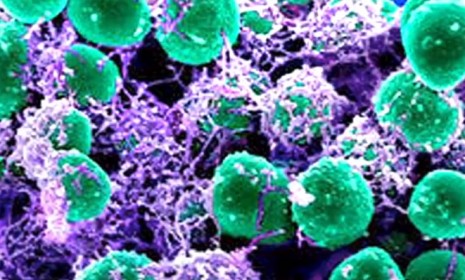The 10,000 species of bacteria that live inside you
Several pounds of microbes are living inside you right now, according to an international team of scientists that was determined to figure out this magic number

Tiny creatures like spidery bacteriophages and wormlike helminth parasites are crawling in or around your body right this very second. For the first time ever scientists have cataloged the 10,000 or so species of microbes living in areas like your gut, and have made the results public through the exhaustive, multi-study Human Microbiome Project. Here's what you should know about the international undertaking:
What did researchers do exactly?
Countless germs and bacteria interact daily with the human body, whether they are inside our mouths or crawling on our skin, and researchers wanted to know exactly how many there are. Hundreds of scientists worldwide took part in the five-year, $173 million effort to catalog "the tiny critters that occupy every inch of the human body inside and out," says Christopher Wanjek at LiveScience, by going through each of the body's microbial "habitats" one at a time. Scientists claim to have finished mapping 99 percent of known organisms, which when tallied up all together amount to several pounds of bacteria living in any regular person (i.e. you). "When you think about it," says George Dvorsky at io9, "we're practically made out of microbes."
The Week
Escape your echo chamber. Get the facts behind the news, plus analysis from multiple perspectives.

Sign up for The Week's Free Newsletters
From our morning news briefing to a weekly Good News Newsletter, get the best of The Week delivered directly to your inbox.
From our morning news briefing to a weekly Good News Newsletter, get the best of The Week delivered directly to your inbox.
Why do this?
The tiny organisms outnumber our cells 10 to 1. There are literally trillions of creatures like protozoa, archaea, parasites, and yeasts living inside us. Ignoring their presence gives us an incomplete understanding of how the human body functions.
So what did the scientists find?
Conditions like body temperature, acidity, and work done by other cells seem to influence what part of the body microbes actually live in. In the intestines, for example, there are roughly 4,000 species of microbes, which are used to help digest nutrients, produce vitamins, and deliver anti-inflammatory compounds. In the female vagina, however, there are only about 300. The reason these "habitats" vary depends on what the body needs to accomplish. The lower number of microbes in the vagina helps ensure that a healthy infant emerges with less risk of infection, for example.
A free daily email with the biggest news stories of the day – and the best features from TheWeek.com
Are any of the microbes dangerous?
Not for the most part. The bugs are "mostly benign," says Michael Winter at USA Today. A few can, on occasion, lead to illnesses. "These bacteria are not passengers," Dr. Phillipp Tarr, one of the lead researchers of Washington University at St. Louis, tells the Associated Press. "They are metabolically active. As a community, we now have to reckon with them like we have to reckon with the ecosystem in a forest or a body of water."
Sources: Associated Press, io9, LiveScience, Washington Post
-
 Political cartoons for December 14
Political cartoons for December 14Cartoons Sunday's political cartoons include a new White House flag, Venezuela negotiations, and more
-
 Heavenly spectacle in the wilds of Canada
Heavenly spectacle in the wilds of CanadaThe Week Recommends ‘Mind-bending’ outpost for spotting animals – and the northern lights
-
 Facial recognition: a revolution in policing
Facial recognition: a revolution in policingTalking Point All 43 police forces in England and Wales are set to be granted access, with those against calling for increasing safeguards on the technology